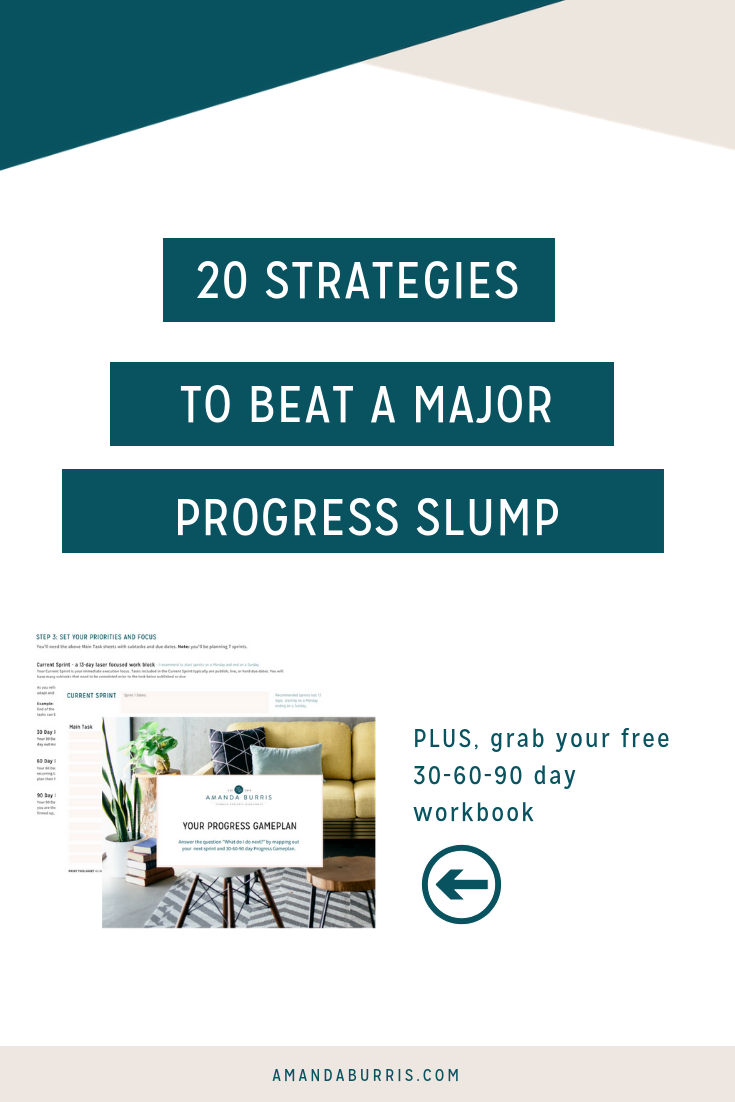 A quick jolt of momentum does a business good, right? If you find yourself (or your business or teams) coming up a little short of your ideal progress tracker, then there are a few things you can try without having that will keep you from hitting the panic button.
A quick jolt of momentum does a business good, right? If you find yourself (or your business or teams) coming up a little short of your ideal progress tracker, then there are a few things you can try without having that will keep you from hitting the panic button.
I’ve categorized these common progress slips and slumps by themes: Decisions & Focus, Tasks, Time, & Resource Management, Planning, Team.
Decisions & Focus
1. Kick decision paralysis to the curb by taking action.
2. You are doing too many things at the same time so you can’t see what (if anything) is actually turning into momentum. Focus on no more than two things at a time.
3. Stop spending time on low hanging fruit. You have to focus the things that really matter.
4. Letting too many voices affect your instincts. Stop asking for people’s opinions, it is just throwing you off.
5. Stay in your genius zone, stop focusing on low hanging fruit.
6. Eyes on your own paper. It doesn’t matter what the experts are doing, your strategies need to work for your business.
7. Stop feeding your excuses. Too busy? Too late? Not smart enough? Good enough?
8. Pause before you decide. Knee jerk reactions are reactionary and often off base.
Planning
1. You keep backtracking over work. Stop, make a plan, and be smart in your resource management.
2. Overplanning is keeping you from jumping into action. You don’t have to see every pine needle in the forest.
3. Under planning is costing you money. Try planning for a sprint then adjusting for the next sprint. You business isn’t sustainable on the no-plan plan.
4. Set a goal, desired end product, and due date. Stop working with no end in sight.
Tasks, Time, & Resource Management
1. You don’t know what you actually accomplished last week. Try a daily recap and sprint review to monitor your completed and incomplete tasks.
2. You aren’t tracking your data. You may be doing the right thing but you don’t why it is or isn’t working. Try tracking your analytics for a week.
3. Set a get out of jail free card so you can work freely, but with resource management (time, money, and energy) in mind.
4. You aren’t making progress because your action items are not not broken down into actual tasks. Too large of a project keeps you from moving things to the DONE! column.
5. Workday or work week is unproductive. Build in a specific distraction free work time every day or week. Monitor where, what kind, and when distractions happen.
6. Keep out of open ended work by setting deadlines and circling back to incomplete tasks.
Team
1. Ask your team. They are the experts and can give you objective advice (but with your strengths and weaknesses in mind).
2. Your team is going in their own directions. Gather them up for an impromptu meeting.
You aren’t always going to be in peak progress mode each and every day.
There are so many things that can slow down your progress and keep you from moving things consistently to done. BUT there are many things you can fix quickly before they spiral out of control. I can’t tell you how many times this week I had to squash a negative thought that was feeding my fears. I have had to call out clients on over or under planning. We had to pause and really dive into numbers, traffic, insights, and all kinds of analytics to make sure we were maximizing not only our inputs but our impact as well.
Not everything has to be overhauled if things start to slip. You have more than you need to jump back into momentum and keep your progress up. I would LOVE for you to learn more about how planning your next 90 days keeps your momentum going and your team focused on the big picture. Try Your Progress Gameplan and dive into sprints!


